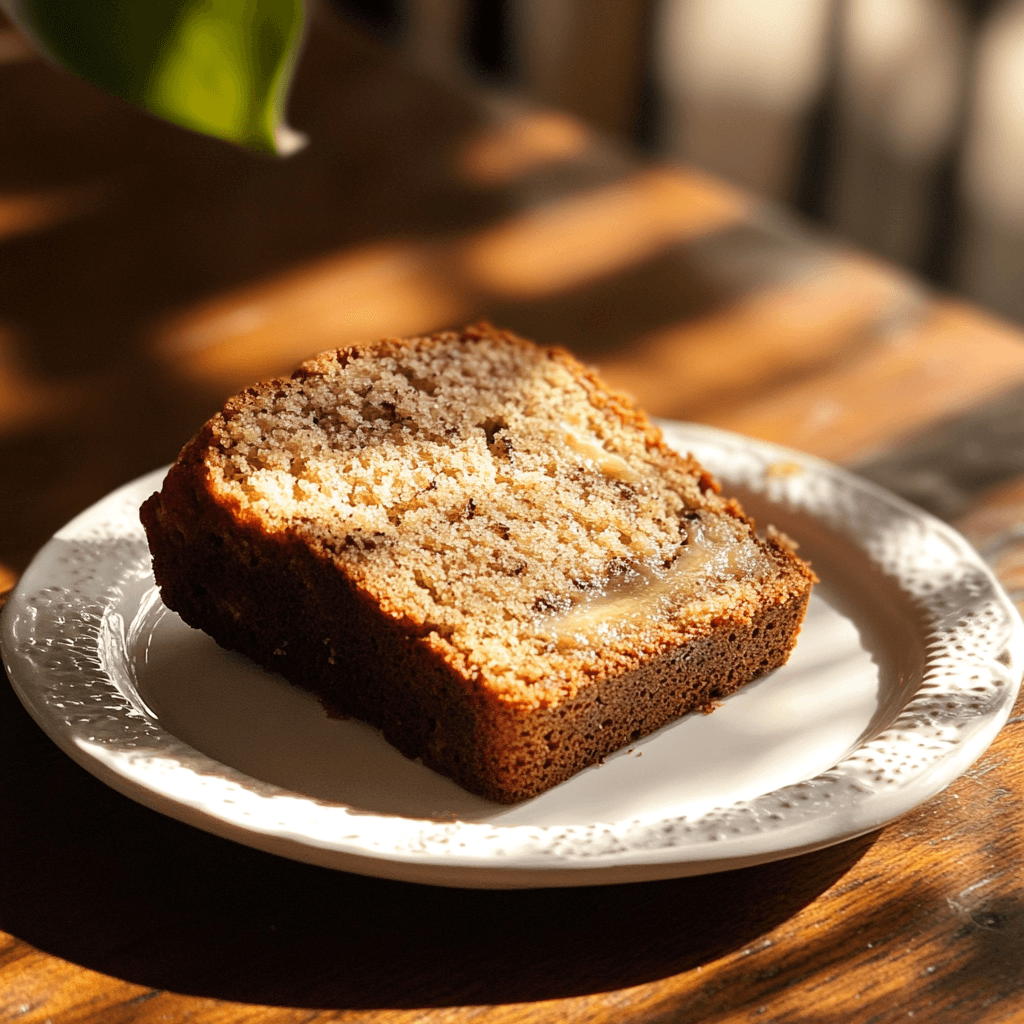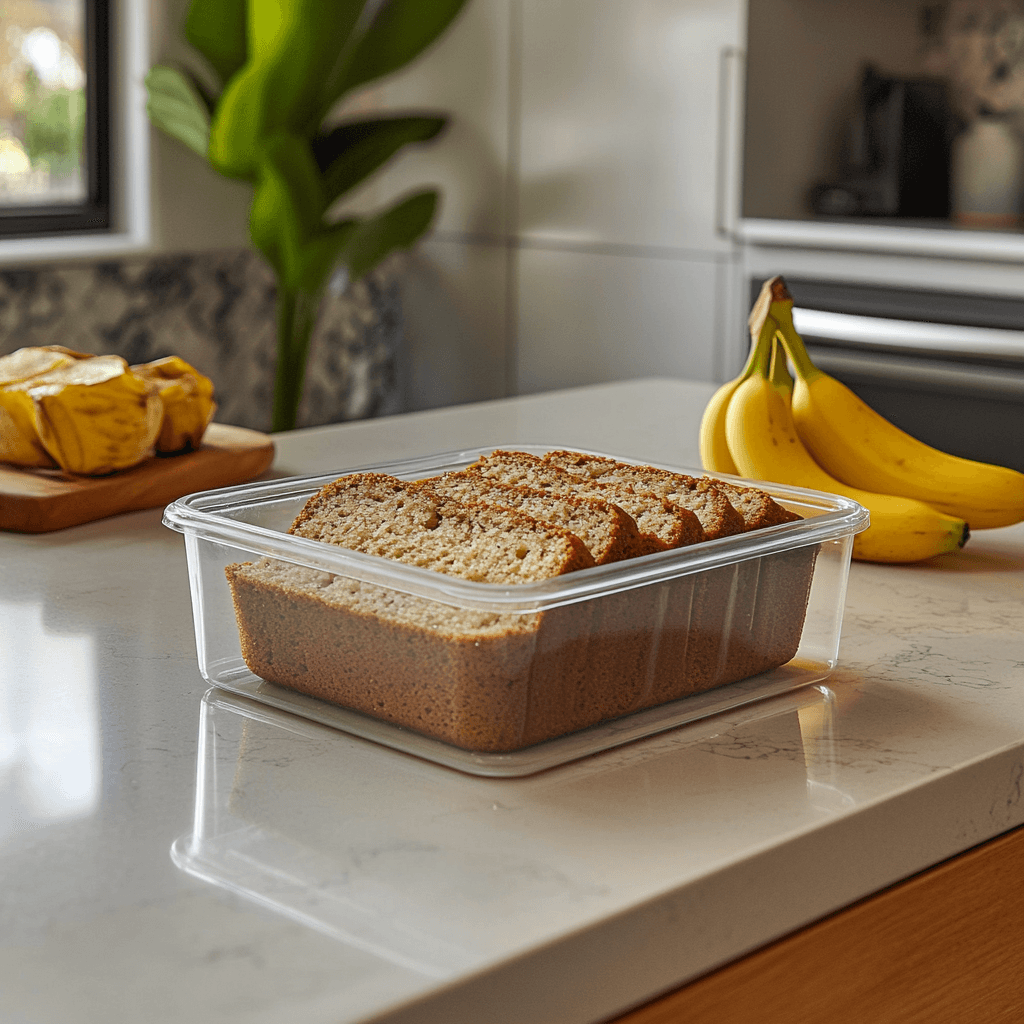Banana bread is a beloved treat, known for its moist texture and deliciously sweet flavor. After baking, proper cooling is an essential step to ensure the bread maintains its quality, texture, and freshness. A common question among home bakers is whether cooling banana bread overnight is safe and effective. The answer depends on several factors, including storage conditions, the ingredients used, and the temperature of your kitchen.

Table of Contents
The Importance of Proper Cooling
When banana bread comes out of the oven, it is still warm and contains residual moisture that needs to evaporate. Leaving the bread out to cool allows this moisture to escape, preventing sogginess and maintaining a pleasant texture. Typically, cooling banana bread on a wire rack for 1–2 hours is sufficient for initial cooling. However, leaving it out overnight requires extra precautions.
Can Banana Bread Be Left Out Overnight?
Yes, banana bread can be left out overnight, but only under certain conditions to avoid spoilage or changes in quality. Here’s what you need to consider:
- Covering the Bread: After the initial cooling period, loosely cover the banana bread with a clean kitchen towel or parchment paper to protect it from dust and pests while allowing some airflow to prevent condensation buildup.
- Room Temperature: Ensure your kitchen is at a cool, stable temperature. Warm or humid environments can promote the growth of mold or bacteria, especially if the bread contains dairy or perishable add-ins like cream cheese or fruit.
- Ingredients: Plain banana bread without perishable toppings or fillings can safely sit out longer than variations containing dairy, nuts, or other sensitive ingredients.
Tips for Overnight Cooling
- Use a Cooling Rack: Place the bread on a wire rack to ensure proper air circulation, which helps prevent sogginess on the bottom.
- Avoid Wrapping Too Soon: Wrapping the bread while it is still warm can trap steam, leading to a soggy texture.
- Inspect in the Morning: Before storing or serving, check for any changes in texture or signs of spoilage.
The Next Morning: Storing Your Banana Bread
After cooling overnight, transfer the banana bread to an airtight container or wrap it tightly in plastic wrap to maintain its freshness. You can store it at room temperature for up to 2–3 days, refrigerate it for up to a week, or freeze it for longer storage.
What Happens When You Leave Banana Bread Out Overnight?

The Science Behind Cooling Baked Goods
When cooling banana bread overnight, several chemical and physical processes occur that can influence its texture, flavor, and freshness. Understanding these processes helps ensure your banana bread remains as delightful as it was when freshly baked. Whether you are leaving banana bread out to cool or simply curious about what happens during the process, knowing the effects of cooling banana bread overnight can help you preserve its quality.
Here’s a closer look at what happens during cooling banana bread overnight:
1. Moisture Redistribution
As banana bread cools, the moisture trapped inside begins to redistribute evenly throughout the loaf. This essential process balances the texture, ensuring the bread remains uniformly moist rather than having moisture concentrated in the center. However, when cooling banana bread overnight, leaving it uncovered can lead to the outer layers drying out, resulting in a crusty or stale texture. To prevent this, it’s important to cover the bread loosely, allowing it to retain its moisture while avoiding condensation.
- Tip: Cover the bread loosely with a towel or parchment paper to allow airflow while minimizing moisture loss.
2. Staling (Retrogradation of Starch)
Starch retrogradation is a natural process that takes place as baked goods cool. During baking, starch molecules absorb water and swell, but as the bread cools, these molecules begin to crystallize, causing the bread to firm up. This process is one reason why banana bread might feel less soft the next day if left exposed. When cooling banana bread overnight, wrapping it properly can help slow down starch retrogradation, keeping the bread softer and fresher for longer.
- Tip: Wrapping banana bread tightly after it cools can help slow down this process, keeping it soft and tender for longer.
3. Flavor Development
Leaving banana bread out overnight can enhance its flavor. Similar to other baked goods, the cooling process allows flavors to meld and intensify. The natural sweetness from the bananas and other ingredients becomes more pronounced, creating a richer taste.
- Tip: While cooling enhances flavor, prolonged exposure to air can lead to oxidation, which may cause the bread to lose some of its fresh aroma.
4. Exposure to Environmental Factors
If the banana bread is left out uncovered, it is susceptible to contamination from dust, insects, or bacteria. Additionally, high humidity can cause the bread to become soggy, while overly dry environments can lead to hardening.
- Tip: Ensure a clean and stable environment, and consider using a breathable cover to protect the bread overnight.
5. Risk of Mold Growth
Banana bread, especially when made with fresh bananas and dairy, has a high moisture content, making it susceptible to mold if left out in warm or humid conditions for extended periods.
- Tip: If your kitchen is warm, transfer the bread to an airtight container and refrigerate it after it cools.
Factors That Affect How Banana Bread Cools
Room Temperature and Its Role in the Cooling Process
Room temperature plays a critical role in how banana bread cools, impacting its texture, freshness, and shelf life. Here’s how:
- Cooling Rate: In cooler environments (60–70°F or 15–21°C), banana bread cools at an ideal pace, allowing the interior to set without drying out the crust. Warmer environments (above 75°F or 24°C) may slow the cooling process and create conditions conducive to bacteria or mold growth.
- Moisture Retention: At room temperature, the bread’s moisture begins to redistribute as it cools. If the air is too dry, the outer layers of the bread may lose moisture, resulting in a tougher crust. Conversely, in humid conditions, the bread may become overly damp and sticky.
- Air Circulation: Proper airflow around the bread is essential. Placing banana bread on a wire rack at room temperature ensures even cooling and prevents the bottom from becoming soggy.
Tips for Cooling at Room Temperature:
- Use a cooling rack to promote airflow.
- Cover the bread lightly with a towel to balance protection and moisture escape.
- Store the bread promptly if room conditions are warm or humid.
The Type of Banana Bread You’ve Made (Moist vs. Dry)
The ingredients and consistency of your banana bread recipe significantly affect how it cools and how long it can safely stay out.
- Moist Banana Bread: Recipes with higher moisture content, such as those made with ripe bananas, yogurt, or sour cream, are more prone to staying soft and flavorful. However, they are also more susceptible to spoilage if left out for extended periods, especially in warm or humid environments.
- Dry Banana Bread: Recipes with less liquid, fewer bananas, or added dry ingredients like nuts or oats tend to cool faster and are less likely to become soggy or sticky. These breads may have a slightly longer shelf life when left out but may not retain the same rich, moist texture.
- Add-ins and Toppings: Banana bread with perishable toppings like cream cheese frosting or fillings such as fruit or chocolate chips requires extra care. These additions can spoil quickly at room temperature, making refrigeration necessary after the initial cooling phase.
Tips Based on Bread Type:
- For moist banana bread, consider transferring it to an airtight container or wrapping it tightly after it cools to lock in freshness.
- For dry banana bread, allow it to cool uncovered for a longer period to prevent excessive moisture retention.
- Always refrigerate banana bread with perishable ingredients after it cools.
The Risks of Leaving Banana Bread Out Overnight

Food Safety Concerns: Bacteria Growth and Spoilage
Leaving banana bread out overnight can pose food safety risks, particularly in environments with high temperatures or humidity. Here’s what to consider:
- High Moisture Content: Banana bread, especially moist recipes, provides an ideal environment for bacteria and mold growth. When left at room temperature for extended periods, the risk increases, particularly if the bread contains perishable ingredients like dairy or fresh fruit.
- Temperature Danger Zone: The USDA identifies the “danger zone” for food as 40°F to 140°F (4°C to 60°C). If banana bread is left in this range for more than 2 hours, particularly in warmer climates, it may develop harmful bacteria.
- Add-Ins and Fillings: Ingredients such as cream cheese, chocolate chips, or fruit fillings can spoil quickly when exposed to room temperature overnight.
Tips to Mitigate Food Safety Risks:
- If your kitchen is warm (above 75°F or 24°C), transfer the bread to the refrigerator after it cools to prevent spoilage.
- Avoid leaving banana bread with perishable toppings or fillings out overnight. Store it in an airtight container in the fridge instead.
- Inspect the bread the next morning for any signs of spoilage, such as an off smell or visible mold.
Texture and Freshness: How Overnight Cooling Impacts Quality
In addition to food safety concerns, leaving banana bread out overnight can affect its texture and freshness. Here’s how:
- Drying Out: Uncovered banana bread is prone to drying out overnight as moisture evaporates from the surface. This can lead to a stale or crumbly texture, particularly for drier recipes.
- Sogginess: Conversely, if the bread is tightly wrapped or left in a humid environment, trapped condensation can make the crust damp and sticky, altering the bread’s overall texture.
- Loss of Freshness: Prolonged exposure to air can cause the flavors and aromas of banana bread to diminish. The bread may lose its fresh-baked taste and develop a slightly oxidized flavor.
Tips to Preserve Texture and Freshness:
- Allow the bread to cool on a wire rack for 1–2 hours before loosely covering it with a clean towel to balance moisture and airflow.
- In humid conditions, transfer the bread to an airtight container or wrap it tightly in plastic wrap to maintain freshness.
- Store leftover banana bread in the refrigerator or freezer for longer preservation.
Best Practices for Cooling Banana Bread
How Long Should Banana Bread Cool Before Storing?
Proper cooling is essential for maintaining the quality, texture, and freshness of banana bread. Storing it too soon can lead to trapped moisture and sogginess, while leaving it out for too long can cause it to dry out. Here’s the ideal timeline:
- Initial Cooling: Allow the banana bread to cool in the pan for 10–15 minutes after removing it from the oven. This helps the structure set and makes it easier to remove from the pan without breaking.
- Wire Rack Cooling: Transfer the bread to a wire rack to cool for 1–2 hours. This step allows air to circulate around the bread, preventing the bottom from becoming soggy while letting residual heat escape.
- Before Storing: Ensure the bread is completely cool to the touch before wrapping or storing. Storing warm bread can lead to condensation, promoting mold growth or ruining the texture.
Tips:
- If you’re in a hurry, you can place the bread in a cool, dry area with good airflow to speed up the cooling process.
- Never store banana bread in its pan, as it can retain heat and moisture, leading to a soggy texture.
Cooling Techniques: Using Wire Racks vs. Leaving It on the Counter
The method you use to cool banana bread significantly impacts its texture and freshness. Here’s a comparison of popular techniques:
- Using Wire Racks
- Pros: Wire racks are the best choice for cooling banana bread. They allow air to circulate underneath the loaf, preventing the bottom from becoming soggy. This method ensures even cooling and maintains the bread’s texture.
- Cons: Requires transferring the bread, which can be tricky if the loaf is very soft or crumbly.
- Leaving It on the Counter
- Pros: Convenient and requires no extra tools. Simply leave the bread on a cutting board, parchment paper, or its pan.
- Cons: Without airflow underneath, the bottom of the bread can trap heat and moisture, leading to a soggy texture. Additionally, leaving the bread out uncovered on the counter for too long can cause it to dry out.
Additional Tips:
- Cover the bread loosely with a towel or parchment paper while it cools on the counter to protect it from dust or contaminants.
- Avoid using plastic wrap or airtight containers during the cooling phase, as these can trap heat and moisture, leading to condensation.
Frequently Asked Questions (FAQs)
Can banana bread be left out overnight without spoiling?
Yes, banana bread can usually be left out overnight without spoiling, provided certain precautions are taken. Ensure the bread is covered loosely with a clean towel or parchment paper to protect it from dust and pests while allowing airflow. If your kitchen is warm or humid, refrigerating the bread after it has cooled is a safer option to prevent mold growth or spoilage.
Should I cover banana bread while cooling?
Yes, but only lightly. During the initial cooling phase, loosely cover the banana bread with a clean kitchen towel or parchment paper. This prevents contaminants from settling on the bread while allowing steam to escape. Avoid tightly covering the bread while it is still warm, as this can trap moisture and make the bread soggy.
Is it safe to leave banana bread out for more than 24 hours?
While banana bread can safely sit at room temperature for up to 24 hours in a cool, dry environment, it’s best to store it in an airtight container after the initial cooling period. Leaving it out longer than 24 hours increases the risk of drying out, mold growth, or spoilage, especially in warm or humid conditions.
How can I make sure my banana bread stays moist after cooling?
To keep banana bread moist:
- Allow it to cool completely before wrapping.
- Wrap it tightly in plastic wrap or aluminum foil, or store it in an airtight container to prevent moisture loss.
- For longer storage, refrigerate or freeze the bread to preserve its texture and flavor.
- Avoid slicing the bread until you’re ready to serve, as slicing exposes more surface area to air, causing it to dry out faster.
Can I leave banana bread out to cool in the fridge?
It’s not ideal to place hot banana bread directly into the fridge, as this can cause condensation, making the bread soggy. Instead, let the bread cool at room temperature on a wire rack for 1–2 hours. Once it’s completely cool, you can refrigerate it to extend its shelf life, especially if your recipe includes perishable ingredients.
What do vegans use for baking?
Vegan baking is more than just a culinary practice—it’s a celebration of creativity, sustainability, and inclusivity. By embracing plant-based ingredients and innovative techniques, bakers can craft delicious treats that cater to diverse dietary needs and ethical values without compromising on flavor or quality.
Conclusion: Is It Safe to Leave Banana Bread Out Overnight to Cool?
Summary and Key Takeaways
Leaving banana bread out overnight to cool can be safe and effective if proper precautions are taken. Here’s what you need to know to ensure your bread stays fresh and safe to eat:
- Safety Depends on Environment: Banana bread can be left out overnight if your kitchen is cool and dry. In warmer or more humid environments, refrigerating the bread after it has cooled is a safer choice to prevent spoilage.
- Cover It Loosely: During the cooling process, cover the bread with a clean towel or parchment paper to protect it from dust and contaminants while allowing airflow to prevent condensation.
- Watch for Perishable Ingredients: Recipes that include dairy, cream cheese, or fruit fillings should not be left out overnight. These breads require refrigeration after cooling.
- Ensure Complete Cooling: Before wrapping or storing, ensure the bread is fully cooled to avoid trapped moisture that can lead to sogginess or mold.
- Storing for Longevity: For the best results, store banana bread in an airtight container or wrap it tightly in plastic wrap. It can be kept at room temperature for 1–2 days, refrigerated for up to a week, or frozen for up to 3 months.
By understanding these key points, you can confidently leave banana bread out overnight in most circumstances, preserving its texture, flavor, and safety for enjoyment the next day.
